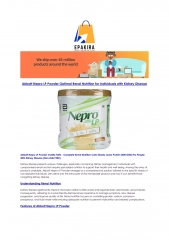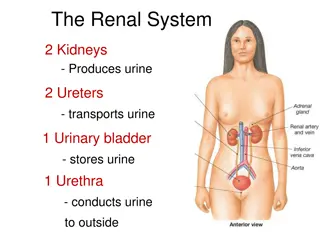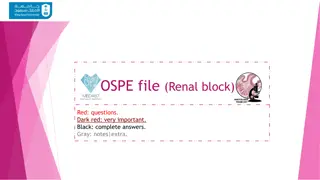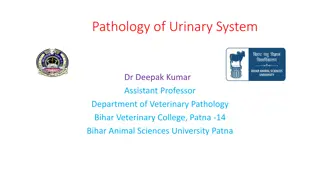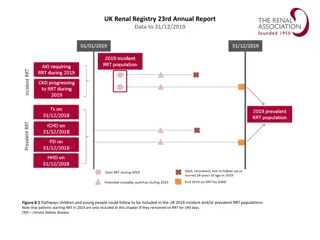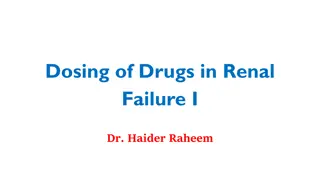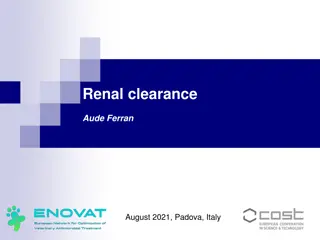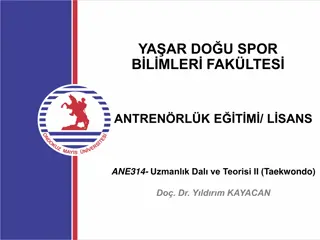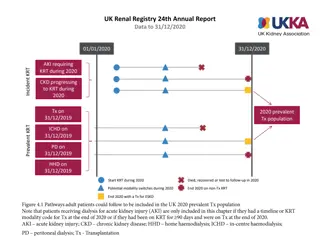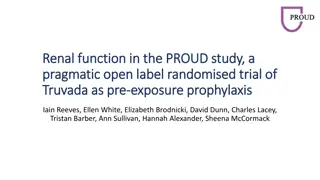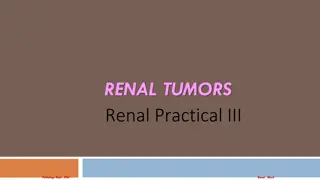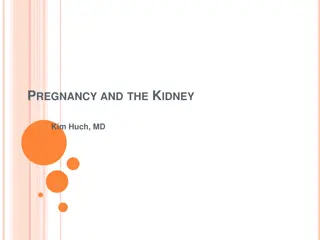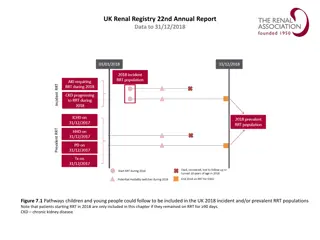Understanding Renal Block: Drugs, Excretion, and Treatment Essentials
Renal block plays a crucial role in drug excretion, with processes like glomerular filtration and tubular secretion affecting drug elimination. Factors like blood flow, physiochemical properties, and urine pH influence renal excretion of drugs. Competition between drugs for transporters can have beneficial or harmful effects. Understanding urinary pH trapping and the necessity of dose adjustments in renal impairment is vital in drug therapy management. Treatment of UTIs involves key drugs like co-trimoxazole, with considerations for contraindications and adverse effects. Overall, grasping the intricacies of renal block mechanisms is imperative in optimizing drug therapy outcomes.
Download Presentation

Please find below an Image/Link to download the presentation.
The content on the website is provided AS IS for your information and personal use only. It may not be sold, licensed, or shared on other websites without obtaining consent from the author. Download presentation by click this link. If you encounter any issues during the download, it is possible that the publisher has removed the file from their server.
E N D
Presentation Transcript
Drugs of Renal Block Important Notes Extra
Renal Excretion Renal excretion of drugs occurs through Passive or active tubular reabsorption Glomerular filtration Active tubular secretion 1-Glomerular filtration Glomerular filtration occurs to : Low MW drugs. Only free drugs. Polar or ionized. e.g aminoglycosides Drugs with low volume of distribution. 2-Active tubular secretion General characteristics of active tubular secretion include; 1-carrier mediated. 2- saturable. 3-Requires energy. 4-transports drugs against concentration gradients. 5-Non-specific. Types of Transporters Transporters for organic acids Transporters for organic bases Aspirin Penicillin Sulfonamide s Probenecid Morphine Catecholamines Atropine Quinine.
Renal Excretion Competition Between Drugs For Same Transporter Beneficial Harmful Competition between Drugs Competition between Drugs Probenecid and Penicillin G Probenecid and Nitrofurantoin Passive or Active Tubular reabsorption Only lipid soluble drugs are passively reabsorbed Ionized drugs are poorly reabsorbed Endogenous substances such as glucose, uric acid, electrolytes, amino acids, and vitamins are actively reabsorbed. Probenecid will inhibit the reabsorption of uric acid so is uricosuric drug. Occurs in DCT and collecting ducts. Factors Affecting Renal Excretion of Drugs Blood flow to the kidney Physiochemical properties of drugs Molecular weight Lipid solubility Degree of ionization Volume of distribution Binding character Volume of distribution Binding character Molecular weight Lipid solubility Degree of ionization Biological factor e.g. age Disease states Urine pH
Renal Excretion Urinary pH trapping (Ion trapping) Urine is normally slightly acidic and favors excretion of basic drugs. Urine acidification by ammonium chloride (NH4Cl) increases excretion of basic drugs. Urine alkalization by by sodium bicarbonate NaHCO3 increases excretion of acidic drugs. NSAIDS e.g aspirin and ibuprofen inhibits the production of PGs and therefore reduces renal perfusion and GFR. Orders of Elimination: What do we do in the case of renal impairement ? Drugs that are primarily excreted by the kidney need dose adjustment when creatinine clearance is below 60 ml/min. Minor dose adjustment if CrCl = 30-60 mL/min. Major dose adjustment if CrCl < 15mL/min. Monitor blood levels of drugs (therapeutic drug monitoring).
Drugs of Renal Block Treatment of UTIs Contraindicat ions Drug Key Points Bactericidal. M.O.A: Sulfamethoxazole inhibits the incorporation of PABA into dihydrofolic acid precursors, and trimethoprim prevents reduction of dihydrofolate to tetrahydrofolate. ratio of TMP to SMX in vivo is 1:20 (formulated 5(SMX):1(TMP)* ADRS: 1. Hypersensitivity. 2. G6PD deficiency. 4. Bleeding and hemolytic anemia -Renal or hepatic failure. -Pregnancy -Nursing mother -Infants < 6 weeks -Blood disorders Co-trimoxazole 3. Displace bilirubin (kernicterus) Effective against E.coli & Staph. Saprophyticus. Urine turns to dark orange-brown (harmless). M.O.A: Sensitive bacteria reduce the drug to an active agent that inhibits various enzymes and damages DNA. Uses: It s usefulness is limited to lower UTI s & cannot be used for upper UT or systemic infections. Dose: 50-100mg, orally, 6h/7 days. Long acting: 100mg twice daily. ADRS: 1.GI disturbance(take with food to avoid Diarrhea) 2. Hemolytic anemia (G6PD Deficiency). 3. Headache and nystagmus -Patients with G6PD deficiency. -Neonates -Pregnancy Nitrofurantoins M.O.A: Inhibit protein synthesis by binding reversibly to 30s subunit Against gm+ve & gm- ve bacteria. given 100 mg orally twice daily Uses: 1. Treatment of UTIs due to Mycoplasma & Chlamydia. 2. Prostatitis. ADRS: 1. Thrombophlebitis - I.V. 2. Brown discolouration of teeth in children. 3. Deformity/growth inhibition of bones in children. -Pregnancy -Breast feeding -Children below 10 years Doxycycline
Drugs of Renal Block Treatment of UTIs Contraindicat ions Drug Key Points Bactericidal. M.O.A: Inhibit bacterial cell wall synthesis. Uses: severe/complicated UTIs & acute prostatitis. ceftriaxone t1/2=4-7 hours, others very short 30-90 mins. ADRS: 1. Hypersensitivity reactions. 2. Thrombophlebitis. Renal or hepatic failure. Cephalosporins 3rd gen e.g ceftriaxone, Ceftazidime. M.O.A: Block bacterial DNA synthesis by inhibiting DNA Gyrase enzyme. Uses: 1. UTIs caused by multidrug resistance organism as pseudomonas. 2. Prostatitis (acute/chronic). gram -ve bacter ADRS: 1. Arthropathy. 2. Phototoxicity. -Not recommended for patients younger than 18 years -Pregnancy -Breastfeeding women Fluoroquinolones (Ciprofloxacin, Moxifloxacin and Gatifloxacin) Given I.M or I.V . poorly absorbed orally (highly charged). Active against gm-ve aerobic organisms. More active in alkaline medium. M.O.A: Inhibit protein synthesis by binding to 30S ribosomal subunits . Similar to tetracyclines. Uses: Severe infections caused by gram negative organism (pseudomonas or enterobacter). ADRS: Ototoxicity. Gentamicin
Drugs of Renal Block Diuretics Contra- indications Drug Key Point Carbonic anhydrase inhibitors (in PCT, interferes with NaHCO3 re-absorption and causes diuresis) Used topically for treatment of open- angle glaucoma. No systemic ADRS or diuresis. Dorzolamide - po, rapid onset, long duration of action - Excreted by active secretion in PCT - Produces alkaline urine and cause metabolic acidosis - Mild in urine volume - excretion of sodium, bicarbonate, potassium, phosphate. Therapeutic uses: - As prophylactic therapy, in acute mountain sickness CSF of brain - Formation of CSF (Useful in treating benign intracranial hypertension) - Urinary alkalinization to enhance renal excretion of acidic substances - Hyperphosphatemia - Adjunct for treatment of epilepsy - Metabolic alkalosis ADRs: - Hypokalemia, Metabolic acidosis, Renal stone formation, Hypersensitivity reaction, CNS effects, tingling, numbness Osmotic Diuretics (In PCT + descending loop) patient with liver cirrhosis Acetazolamide - Poorly absorbed by GI, given I.V, if given PO will cause osmotic diarrhea, Not metabolized - Excreted by glomerular filtration without being re-absorbed or secreted within 30-60 min - urine output by osmosis Therapeutic uses: - Acute renal failure due to shock or trauma - acute drug poisoning - maintain urine volume & prevent anuria resulting from large pigmentation load to the kidney Chronic heart failure Mannitol
Drugs of Renal Block Cont. Osmotic Diuretics Drug Key Point Contraindications - To intracranial & intraocular pressure before ophthalmic or brain procedures (cerebral edema). ADRs: - Headache, nausea, vomiting - Extracellular volume expansion - Excessive use will cause dehydration & hypernatraemia Mannitol Loop diuretics M.O.A: Inhibit Na/K/2Cl co-transporter in the luminal membrane of the thick ascending loop of Henle &inhibit reabsorption of Ca&Mg -increase urinary excretion of Na/k/2cl and paracellularly Ca and Mg. -High natriuresis -Oral or IV -Emergency use -Excretion of active tubular secretion of weak acids into urine -USES: Edema associated w/ CHF & nephrotic syndrome- Acute hypercalcemia & acute hyperkalemia, Br, F, I toxicity ADRS: ototoxicity/metabolic alkalosis/allergic reactions Drug-drug interactions: 1- NSAIDs: reduce diuretic response 2-digitalis: arrhythmia 3-aminoglycosides: increase ototoxicity Furosemide Torsemide Bumetanide Ethacrynic acid Thiazide diuretics -M.O.A: acts via inhibition of Na/Cl co- transporter on the luminal membrane of distal convoluted tubules. -P.K: moderate efficacy natriuresis & given orally. -Uses: essential hypertension, mild heart failure & edema,osteoporosis, Calcium nephrolithiasis, Nephrogenic diabetes insipidus. -ADRs: Fluid and electrolyte imbalance,Hyponatremia, Hypovolemia (volume depletion) Hypokalemia, Metabolic alkalosis, Hyperuricaemia (gout), Hypercalcemia, Hyperglycaemia & Hyperlipidemia. Chlorothiazide Hydrochlorothiaz ide Chlorthalidone Metolazone Indapamide Drug- drug interactions: 1- Uricosurics diminish Thiazide effect. 2-Thiazide increase Digitalis effect. 3- NSAIDs Reduce Thiazide efficacy
Drugs of Renal Block Potassium Sparing Diuretics Drug Key Point Contraindications Aldosterone Antagonists -act at the collecting duct by competitive inhibition of cytoplasmic aldosterone receptors - urinary Na+ excretion - urinary K+ excretion (Hyperkalemia ) - H+ excretion (acidosis) -has antiandrogenic action. Uses : -Treatment of hypertensioncombined with thiazide or loop diuretics to: -Enhance natriuresis caused by other diuretics - Correct for hypokalemia -Treatment of primary hyperaldosteronism (Conn's syndrome) -Treatment of secondary hyperaldosteronism in diseases as CHF, Edema of hepatic cirrhosis(drug of choice), Nephrotic syndrome. -Treatment of hirsutism, acne due to the antiandrogenic effects. ADRS: Hyperkalaemia,Metabolic acidosis,Gynecomastia ,Impotence,Menstrual irregularities,GIT upset and peptic ulcer. -Hyperkalaemia: chronic renal failure K+ supplement use* -blockers* ACE inhibitors*. -Liver disease (dose adjustment is needed) Digitalis-Spironolactone alters it s clearance Salicylates-decrease efficacy and secretion. Spironolactone Eplerenone *Drug-Drug Interaction Because it will lead to Hyperkalemia induced by K-Sparing diuretics Na+ Channels Inhibitors -Inhibition of Na influx through directly blockade of the epithelial sodium channel epithelial sodium channel (ENaC) on the lumen side of the kidney collecting tubule. Uses: -Used in Combination with Loop & Thiazide Diuretics -Treatment for lithium-Induced Diabetes Insipidus. ADRS: -Hyperkalemia -Renal stones(Triamterene) in patients who are also on -ACE inhibitors, - angiotensin II receptor antagonists -other potassium sparing diuretics - potassium-containing supplements. Amiloride Triamterene
It is not hard, you just made it to the end! Team Leaders: Yazeed Alharbi & Hadeel Awartani Thanks for those who worked on this lecture: Nouf Al Otaibi Dimah Al Araifi Ghaida Al Sanad Fatimah Al Bassam Adel Alsuhaibani Abdullah Almoaither Faisal Alhawtan References: Doctors notes and slides @Pharma4370 pharmacology437@gmail.com


